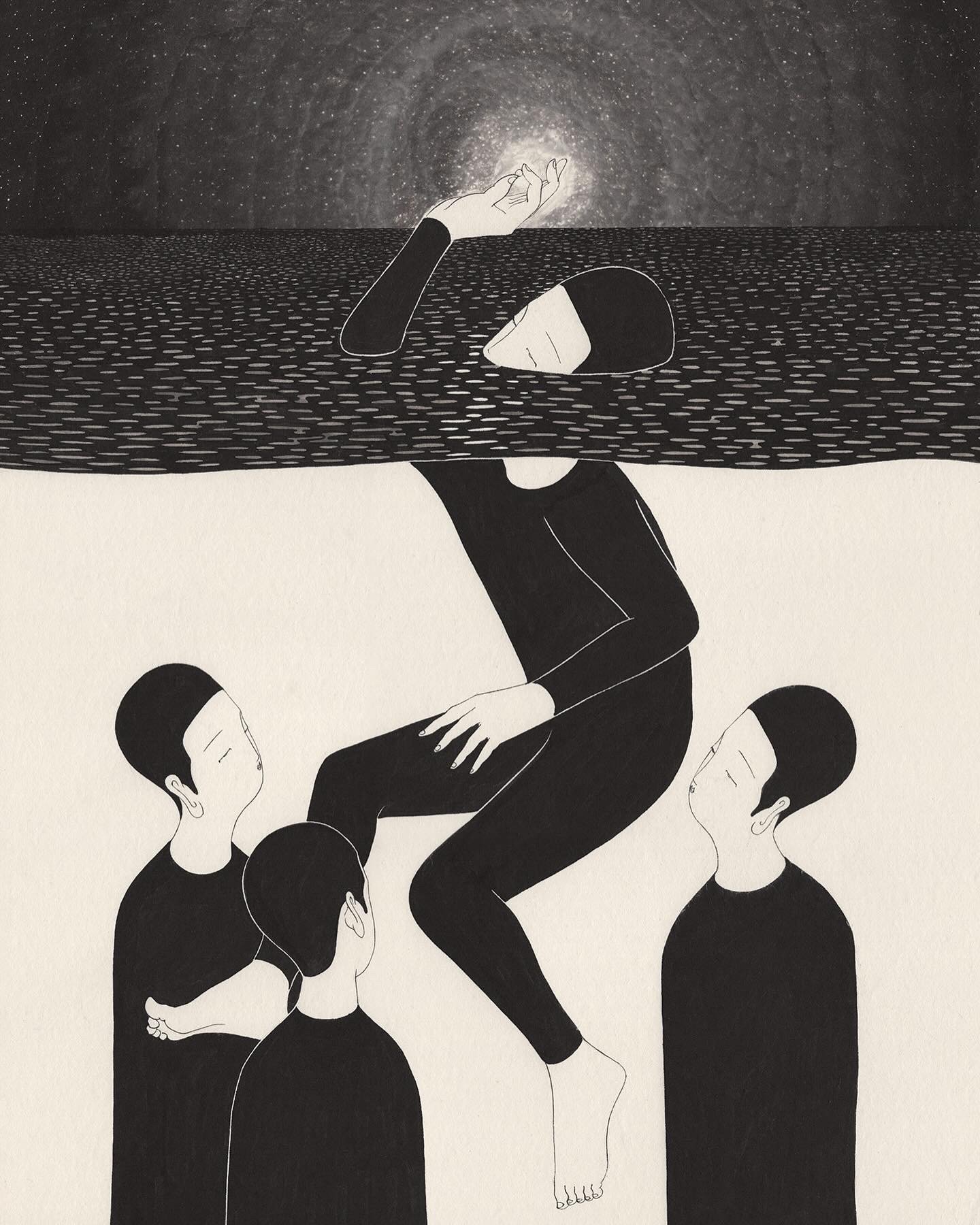To talk about the enormous presence in the painting—one even larger than that, and one even greater still—I must first speak of the giant eye that often appeared in my earlier works.
Since childhood, when I walked at night and saw the moon—especially a waning gibbous moon—it always felt like a giant eye in the sky. No matter where I went, it seemed to watch me from the same place, sometimes staring intently, sometimes glaring sharply, and at times gazing at me with sorrowful sympathy. Being aware of this vast gaze made me see myself as a distinct being, objectively observing and reflecting on my existence.
<밤에 / Part of universe>의 부분, 2011
The moment I recognize the moon as an eye, my perspective shifts—I am no longer beneath the sky but outside of it, pressing my face against a hole in its surface, becoming an immense being beyond it all. And the moment I imagine myself in that position, I conceive of yet another presence that observes everything from an even higher vantage point. It is as if, the very instant I perceive something, I feel a sharp separation between myself and the world. Looking at the moon becomes like peering through a spectroscope, splitting myself into multiple versions, each observing the other.
In my daily life, I experience different events and emotions. When I am immersed in those emotions, I am trapped within my singular body, unable to see beyond myself. I am unaware of the vast gaze above me. But the moment I acknowledge that a greater presence is watching me, I shrink into an object of observation—no longer just feeling emotions intensely, but instead imagining them from a distance, like an outsider looking in.
This observer looks at my curled-up self and wonders what emotions might be inside. It imagines sadness with curiosity, finds humor in sorrow, and recalls painful memories even in moments of laughter. Because those emotions do not fully belong to the observer, they can be examined, turned over, and played with. In this way, I have learned how to step outside of my emotions.
The larger version of me can comfort the smaller me, helping it smile again. The even greater version of me can lift up the one just below it. And the greatest version of me of all can help the standing self take another step forward.
<보기 보기 보기 / Example of seeing seeing>의 부분,
그림 속에 등장하는 거대한 존재, 그보다 더 큰 존재, 그보다 더욱더 큰 존재에 대해 얘기하려면, 예전 그림에 등장하곤 했던 거대한 눈에 관해 이야기해야 할 것입니다.
어릴 적부터 밤 산책을 하다가 마주치는 달, 그중에서도 하현망의 달을 보면 꼭 하늘에 떠 있는 거대한 눈 같다는 생각을 했었습니다. 그 거대한 눈이 어디를 가든 같은 자리에서 나를 지긋이 바라보고, 매섭게 노려보고, 또 동정하듯 애처롭게 쳐다보기도 합니다. 그 거대한 시선을 의식하는 일이, 나를 하나의 개체로 객관화하여 바라보고 관찰하게 된 계기가 되었습니다.
내가 하늘의 달을 눈으로 인식하는 순간, 나는 하늘 바깥으로 빠져나가 하늘의 겉면에 난 구멍에 얼굴을 가져다 댄 거대한 존재로 위상이 바뀌어 버리고, 그런 나 자신을 상상하는 순간 그 모두를 관조하는 또 다른 존재를 상정하게 됩니다. 마치 내가 어떤 대상을 인식하는 순간 내가 세상으로부터 철컹 분리되는 느낌이 드는 것처럼, 하늘의 달을 쳐다보는 일은 마치 분광기를 통해 내가 여러 존재로 쪼개어지는 환각을 갖게 합니다.
평소의 나는 여러 일을 겪고 그때마다 감정에 처합니다. 감정에 처해 있음은 나라는 단일한 육체에 갇혀있어 나의 외부를 보지 못하는, 바깥에서 나를 보지 못하는, 하늘에 떠 있는 시선을 인식하지 못하는 상태의 나일 것입니다. 그러나 그런 나를 바라보는 거대한 존재를 상정하는 순간, 나는 타자로 쪼그라들고, 실감 나게 감정을 느끼던 존재에서 그 감정을 상상해 봐야만 하는 관찰자로 둔갑하게 됩니다.
관찰자는 조그맣게 웅크려 있는 나를 바라보고, 그 안에 어떤 감정이 있을지 상상해 봅니다. 상상하는 관찰자는 슬픈 감정을 재미있게 여기기도 하고, 웃기는 이야기에서 슬픈 일을 떠올리기도 합니다. 그 감정이 나의 것이 아니기에 요리조리 살펴보고 가지고 놀 수 있게 된 것입니다. 나는 그런 방법으로 감정에서 빠져나오는 방법을 알게 되었습니다.
거대한 나는, 작은 나를 위로해 주고 다시 웃게 만들 수 있습니다. 더 거대한 나는 나의 조금 작은 나를 일으켜 세울 수 있습니다. 더욱더 거대한 나는 일어선 나를 나와 다시금 앞으로 나아가게 할 수 있습니다.
<나는나와나의나를 / Meme>, 194 x 130.3 cm, 한지에 먹과 아크릴, Ink and acrylic on Hanji. 2024








































































